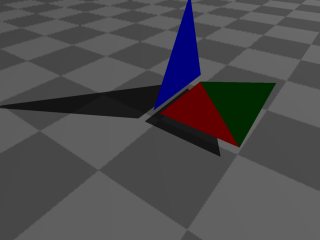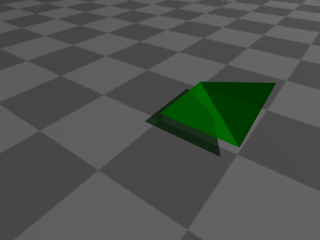Parametric Surfaces in POV-Ray (work in progress)
This page shows you POV-Ray's syntax for parametric surfaces (math). If you don't know POV-Ray, please see POV-Ray: Intro.
The “mesh” Patch
The “mesh” primitive is just a list of triangles, as simple as that. Here's a example:

Here's the syntax for the mesh primitive:
#declare c1 = texture {pigment {color Red}} #declare c2 = texture {pigment {color Green}} #declare c3 = texture {pigment {color Blue}} mesh{ triangle{<0,0,0>,<1,0,0>,<0,0,1> texture { c1 }} triangle{<1,0,0>,<0,0,1>,<1,.3,1> texture { c2 }} triangle{<-0.1,0,0>,<-0.1,0,1.2>,<-0.1,1.2,0.7> texture { c3 }} translate <0,.1,0> }
Note that in the mesh primitive, texture must be predefined. This is just how POV-Ray is.
The “mesh2” Primitive
In a parametric surface, the list of triangles making up the surface share edges and vertexes. If we were to save the surface data as a list of triangles, there will a lot of repetitions of the vertex coordinates. It would be much more efficient, to simply store all the vertexes in a surface as a list, and store another list that specifies which of vertexes are connected to form a triangle.
In POV-Ray, there's a “mesh2” primitive, that stores a surface as a list of vertexes and a list of faces, using indexes of the vertex list. Here's a example:
mesh2 { vertex_vectors { 4 /* number of vertexes*/, <0,0,0>, <1,0,0>, <1,0.3,1>, <0,0,1> // a listing of the vertex } face_indices { 2 /* number of faces*/, <0,1,3>, /*indexes from the vertex_vectors list*/ <1,2,3> } }
In the above, the mesh2 primitive has vertex_vectors{} and face_indices{} as components. In vertex_vectors, it start with the number of total vertexes, following by the vertexes. In face_indices, it start by the number of faces, followed by a set of triangles, each triangle is of the form <v1,v2,v3>, where the v1, v2, v3 are the indexes from the vertex_vectors list, each representing a corner of the triangle.

The “polygon” Patch
Height Field
Parametric Surfaces
work in progress
IsoSurfaces
POV-Ray has a feature that allows you to plot isosurface. More specifically, you can use it to plot the roots of polynomial of 3 variables.
For example, the equation for a torus is
(R-Sqrt[x^2+y^2])^2 +z^2 - r^2 == 0 where R is the major radius and r is the minor radius.
work in progress